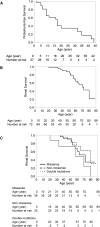Genetic, Clinical, and Pathologic Backgrounds of Patients with Autosomal Dominant Alport Syndrome
- PMID: 27281700
- PMCID: PMC4974872
- DOI: 10.2215/CJN.01000116
Genetic, Clinical, and Pathologic Backgrounds of Patients with Autosomal Dominant Alport Syndrome
Abstract
Background and objectives: Alport syndrome comprises a group of inherited heterogeneous disorders involving CKD, hearing loss, and ocular abnormalities. Autosomal dominant Alport syndrome caused by heterozygous mutations in collagen 4A3 and/or collagen 4A4 accounts for <5% of patients. However, the clinical, genetic, and pathologic backgrounds of patients with autosomal dominant Alport syndrome remain unclear.
Design, setting, participants, & measurements: We conducted a retrospective analysis of 25 patients with genetically proven autosomal dominant Alport syndrome and their family members (a total of 72 patients) from 16 unrelated families. Patients with suspected Alport syndrome after pathologic examination who were referred from anywhere in Japan for genetic analysis from 2006 to 2015 were included in this study. Clinical, laboratory, and pathologic data were collected from medical records at the point of registration for genetic diagnosis. Genetic analysis was performed by targeted resequencing of 27 podocyte-related genes, including Alport-related collagen genes, to make a diagnosis of autosomal dominant Alport syndrome and identify modifier genes or double mutations. Clinical data were obtained from medical records.
Results: The median renal survival time was 70 years, and the median age at first detection of proteinuria was 17 years old. There was one patient with hearing loss and one patient with ocular lesion. Among 16 patients who underwent kidney biopsy, three showed FSGS, and seven showed thinning without lamellation of the glomerular basement membrane. Five of 13 detected mutations were reported to be causative mutations for autosomal recessive Alport syndrome in previous studies. Two families possessed double mutations in both collagen 4A3 and collagen 4A4, but no modifier genes were detected among the other podocyte-related genes.
Conclusions: The renal phenotype of autosomal dominant Alport syndrome was much milder than that of autosomal recessive Alport syndrome or X-linked Alport syndrome in men. It may, thus, be difficult to make an accurate diagnosis of autosomal dominant Alport syndrome on the basis of clinical or pathologic findings. No modifier genes were identified among the known podocyte-related genes.
Keywords: Alport syndrome; Autosomal dominant; COL4A3; COL4A4; Glomerular Basement Membrane; Hearing Loss; Humans; Japan; Phenotype; Renal Insufficiency, Chronic; kidney; proteinuria.
Copyright © 2016 by the American Society of Nephrology.
Figures


References
-
- Kashtan CE, Michael AF: Alport syndrome. Kidney Int 50: 1445–1463, 1996 - PubMed
-
- Kashtan CE: Alport syndrome and the X chromosome: Implications of a diagnosis of Alport syndrome in females. Nephrol Dial Transplant 22: 1499–1505, 2007 - PubMed
-
- Papazachariou L, Demosthenous P, Pieri M, Papagregoriou G, Savva I, Stavrou C, Zavros M, Athanasiou Y, Ioannou K, Patsias C, Panagides A, Potamitis C, Demetriou K, Prikis M, Hadjigavriel M, Kkolou M, Loukaidou P, Pastelli A, Michael A, Lazarou A, Arsali M, Damianou L, Goutziamani I, Soloukides A, Yioukas L, Elia A, Zouvani I, Polycarpou P, Pierides A, Voskarides K, Deltas C: Frequency of COL4A3/COL4A4 mutations amongst families segregating glomerular microscopic hematuria and evidence for activation of the unfolded protein response. Focal and segmental glomerulosclerosis is a frequent development during ageing. PLoS One 9: e115015, 2014 - PMC - PubMed
-
- Xie J, Wu X, Ren H, Wang W, Wang Z, Pan X, Hao X, Tong J, Ma J, Ye Z, Meng G, Zhu Y, Kiryluk K, Kong X, Hu L, Chen N: COL4A3 mutations cause focal segmental glomerulosclerosis. J Mol Cell Biol 6: 498–505, 2014 - PubMed
-
- Malone AF, Phelan PJ, Hall G, Cetincelik U, Homstad A, Alonso AS, Jiang R, Lindsey TB, Wu G, Sparks MA, Smith SR, Webb NJ, Kalra PA, Adeyemo AA, Shaw AS, Conlon PJ, Jennette JC, Howell DN, Winn MP, Gbadegesin RA: Rare hereditary COL4A3/COL4A4 variants may be mistaken for familial focal segmental glomerulosclerosis. Kidney Int 86: 1253–1259, 2014 - PMC - PubMed
Publication types
MeSH terms
Substances
LinkOut - more resources
Full Text Sources
Other Literature Sources
Molecular Biology Databases

